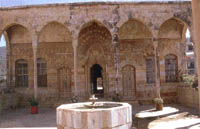Marjeyoun
Profile Altitude:
783m
Distance from Beirut: 85km
Getting
There
From Beirut, take Khalde Highway South passing through Khalde, Damour, Naame, Saadiat, along the beautiful coast of the Mediterranean sea,
Saidon, Ghazieh, Sarafand, Adloun,
Tyre, Qana, Nabatieh, Kfartibnit, Arnun to Marjeyoun. |

|
General Information
Marjeyoun more properly "Jedaidat Marjayoun" is famous as the
place of origin of many distinguished Lebanese emigrants and their families,
such as the first jet ace, Major James Jabara, of Korean war frame, and for
Mrs. Kerr's Self Help Center. It is important locally as the largest Lebanese
town of the South Beqaa and as the district headquarters, as well as being the
market center of the region. It has always been an army garrison town,
guarding the nearby (8 kms) Palestinian frontier, and being in a commanding
position on its hillside, provides many scenic views of the surrounding
countryside.
But that it also holds interesting antiquities is generally
unknown.
The name itself may come from the ancient lost city of Iyyon by
later confusion with ayoun, the Arabic plural for "spring". "Marj" of course is
simply "plain", thus "Plain of the Springs". The plain proper extends south from
the present town to the Palestinian frontier and is surrounded on three sides by
hills. Near the north end of the plain and less than two kilometers below the
town is Tell Debbin, thought to be the actual site of the lost Iyyon.
The town owes its name to a large number of water sources and springs forming
small rivers, which made the surrounding plain very fertile.
It has a wide variety of trees and is famous for its beautiful landscape and
mild climate. The most important source is the al Dardarah spring to the east,
near al Khiam not far from the southern Lebanese border. This is surrounded by
outdoor restaurants serving Lebanese food. Several banks, hotels and hospitals
are found in Jdeidet Marjayoun. In its vicinity, the tourist can visit many
archeological sites, such as Al Shqif, Tell Dibbin (where you can still find
ancient tombs) and Hasbaya. Near Dibbin is the mausoleum of Nabi Hizine.
Three kilometers north of Marjayoun is the mausoleum of the prophet Ezekiel, a
holy shrine visited by believers seeking the prophet’s blessing. Eight
kilometers east of Jdeidet Marjayoun lies the village of Ibl al Saqi, famous
for its beautiful houses and the springs that made the agricultural
development of the village possible. Before the war, local authorities opened
the so-called “Farmer’s house,” an institution aiming at raising the living
standard of the peasants. A cultural and social club contributed to this
project by creating workshops for traditional handicrafts.
South of Ibl al Saqi lies al Khiam, a fairly big town with houses built on a
hill overlooking the plain of Marjayoun. The al Dardarah spring bursts out
west of the locality and irrigates its fields and orchards.
Near Qlayya south of Marjayoun is an old monastery known as Qedissa Hanni
which stands on a high hill visible from the road. The huge structure, with
its own underground stables, is in ruin with the exception of a small chapel
installed in 1993. You then reach Adayse and Mays al Jabal where you can
visit an old Mosque said to belong to one of the Prophet’s companions, Abi Zor
al ghafari. In Blida (30 km), there is an 18th century mosque with an old
well. Below Blida village are three old springs, now covered, around which
many legends are told.
Further south is the village of Kfar Kila and the important mausoleum and
shrine of Nabi Khodor who is related to Mar Jurious (St. George).
South
Lebanon is the region extending from the Awali river in the North to Ras El
Naqoura in the South and from the Mediterranean sea in the west to the
Syro-Lebanese borders in the East.
Towns and villages of the mountain area lie at an altitude of 800 to 1500m. In
Mount Niha are the most famous summer resorts of South Lebanon: Jezzine,
Kfarhouna, Roum, Aramta, Bkassine, Jbaa, Jarjou and Arab Salim.
East of the coastal plains, rise the hills which form the largest part of South
Lebanon. Their altitude steadily increases to reach 1000m. They are watered by
the Qasmieh River (Litani) and covered with olive, apple, almond, pine and oak
trees.
Information From the Ministry of
Tourism

|